Hydrogen-Induced Cracking in CGHAZ of Welded X80 Steel under Tension Load
Abstract
1. Introduction
2. Experimental
2.1. Materials and Specimens
2.2. Metallographic Observation
2.3. Tensile and Hydrogen Permeation Testing
2.4. Characterization of the Fracture Surface
3. Results and Discussion
3.1. Effect of Heat Input on Tensile Properties
3.2. Tensile Properties of CGHAZ with Different Heat Inputs at Different Hydrogen Concentrations
3.3. Fracture Surface Analysis of CGHAZ with Different Heat Inputs
3.4. Mechanism of the Difference in Sensitivity of LB and GB to HIC under a Tensile Load
4. Conclusions
- An increment in hydrogen concentration resulted in an increased Young’s modulus of BM during the elastic stretching stage. However, this effect was not prominent in CGHAZ. The UTS of CGHAZ gradually decreased with the increase in hydrogen concentration. Once the material was exposed to hydrogen, the material plasticity dropped sharply at first and then decreased slowly with the increased hydrogen concentration.
- The HI 29.2 specimen had the lowest sensitivity to HE under tensile load. The HE sensitivity of HI38.3 and HI48.5 became less affected by the hydrogen concentration gradient. The HE susceptibility of HI18.1 was the highest, and its HE susceptibility increased rapidly with the hydrogen concentration.
- In the presence of hydrogen, the fracture surface showed brittle fracture characteristics. HI08.5 demonstrated intergranular fracture behavior. HI18.1 showed mixed transgranular and intergranular fractures. For HI29.2, the fracture surface mainly showed a transgranular fracture with stepped truncation. For HI38.3 and HI48.5, the fracture surfaces exhibited transgranular brittle fracture, with the surfaces becoming progressively flatter.
- Steels predominantly composed of bulk LB were vulnerable to hydrogen embrittlement and exhibit intergranular cracking. A fine LB and GB composite structure can remarkably obstruct intergranular cracks, giving a superior resistance to hydrogen embrittlement. The LB content of hydrogen-resistant steels is expected to be about 11%, and LB should be scattered in GB.
Author Contributions
Funding
Data Availability Statement
Conflicts of Interest
References
- Koohi-Fayegh, S.; Rosen, M.A. A Review of Energy Storage Types, Applications and Recent Developments. J. Energy Storage 2020, 27, 101047. [Google Scholar] [CrossRef]
- Smith, C.; Hill, A.K.; Torrente-Murciano, L. Current and Future Role of Haber–Bosch Ammonia in a Carbon-Free Energy Landscape. Energy Environ. Sci. 2020, 13, 331–344. [Google Scholar] [CrossRef]
- Abdin, Z.; Zafaranloo, A.; Rafiee, A.; Mérida, W.; Lipiński, W.; Khalilpour, K.R. Hydrogen as an Energy Vector. Renew. Sustain. Energy Rev. 2020, 120, 109620. [Google Scholar] [CrossRef]
- Dawood, F.; Anda, M.; Shafiullah, G.M. Hydrogen Production for Energy: An Overview. Int. J. Hydrogen Energy 2020, 45, 3847–3869. [Google Scholar] [CrossRef]
- Messaoudani, Z.L.; Rigas, F.; Binti Hamid, M.D.; Che Hassan, C.R. Hazards, Safety and Knowledge Gaps on Hydrogen Transmission via Natural Gas Grid: A Critical Review. Int. J. Hydrogen Energy 2016, 41, 17511–17525. [Google Scholar] [CrossRef]
- Jaworski, J.; Kułaga, P.; Blacharski, T. Study of the Effect of Addition of Hydrogen to Natural Gas on Diaphragm Gas Meters. Energies 2020, 13, 3006. [Google Scholar] [CrossRef]
- Zhang, P.; Laleh, M.; Hughes, A.E.; Marceau, R.K.W.; Hilditch, T.; Tan, M.Y. A Systematic Study on the Influence of Electrochemical Charging Conditions on the Hydrogen Embrittlement Behaviour of a Pipeline Steel. Int. J. Hydrogen Energy 2023, 48, 16501–16516. [Google Scholar] [CrossRef]
- Zhang, L.; Shen, H.; Lu, K.; Cao, W.; Sun, Y.; Fang, Y.; Xing, Y.; Du, Y.; Lu, M. Investigation of Hydrogen Concentration and Hydrogen Damage on API X80 Steel Surface under Cathodic Overprotection. Int. J. Hydrogen Energy 2017, 42, 29888–29896. [Google Scholar] [CrossRef]
- Singh, V.; Singh, R.; Arora, K.S.; Mahajan, D.K. Hydrogen Induced Blister Cracking and Mechanical Failure in X65 Pipeline Steels. Int. J. Hydrogen Energy 2019, 44, 22039–22049. [Google Scholar] [CrossRef]
- Sanchez, L.; Cong, H. AC Interference on Hydrogen Absorption in Low Carbon Steel under Cathodic Protection. Int. J. Hydrogen Energy 2023, 48, 1202–1217. [Google Scholar] [CrossRef]
- Zhang, T.; Zhao, W.; Li, T.; Zhao, Y.; Deng, Q.; Wang, Y.; Jiang, W. Comparison of Hydrogen Embrittlement Susceptibility of Three Cathodic Protected Subsea Pipeline Steels from a Point of View of Hydrogen Permeation. Corros. Sci. 2018, 131, 104–115. [Google Scholar] [CrossRef]
- An, T.; Zhang, S.; Feng, M.; Luo, B.; Zheng, S.; Chen, L.; Zhang, L. Synergistic Action of Hydrogen Gas and Weld Defects on Fracture Toughness of X80 Pipeline Steel. Int. J. Fatigue 2019, 120, 23–32. [Google Scholar] [CrossRef]
- Zhou, D.; Li, T.; Huang, D.; Wu, Y.; Huang, Z.; Xiao, W.; Wang, Q.; Wang, X. The Experiment Study to Assess the Impact of Hydrogen Blended Natural Gas on the Tensile Properties and Damage Mechanism of X80 Pipeline Steel. Int. J. Hydrogen Energy 2021, 46, 7402–7414. [Google Scholar] [CrossRef]
- Li, X.; Ma, X.; Zhang, J.; Akiyama, E.; Wang, Y.; Song, X. Review of Hydrogen Embrittlement in Metals: Hydrogen Diffusion, Hydrogen Characterization, Hydrogen Embrittlement Mechanism and Prevention. Acta Metall. Sin. (Engl. Lett.) 2020, 33, 759–773. [Google Scholar] [CrossRef]
- Zhao, H.; Chakraborty, P.; Ponge, D.; Hickel, T.; Sun, B.; Wu, C.-H.; Gault, B.; Raabe, D. Hydrogen Trapping and Embrittlement in High-Strength Al Alloys. Nature 2022, 602, 437–441. [Google Scholar] [CrossRef] [PubMed]
- Liu, Q.; Venezuela, J.; Zhang, M.; Zhou, Q.; Atrens, A. Hydrogen Trapping in Some Advanced High Strength Steels. Corros. Sci. 2016, 111, 770–785. [Google Scholar] [CrossRef]
- Sun, Y.; Cheng, Y.F. Hydrogen Permeation and Distribution at a High-Strength X80 Steel Weld under Stressing Conditions and the Implication on Pipeline Failure. Int. J. Hydrogen Energy 2021, 46, 23100–23112. [Google Scholar] [CrossRef]
- Sun, Y.; Cheng, Y.F. Thermodynamics of Spontaneous Dissociation and Dissociative Adsorption of Hydrogen Molecules and Hydrogen Atom Adsorption and Absorption on Steel under Pipelining Conditions. Int. J. Hydrogen Energy 2021, 46, 34469–34486. [Google Scholar] [CrossRef]
- Köse, C. Effect of Heat Input and Post Weld Heat Treatment on the Texture, Microstructure and Mechanical Properties of Laser Beam Welded AISI 317L Austenitic Stainless Steel. Mater. Sci. Eng. A 2022, 855, 143966. [Google Scholar] [CrossRef]
- Köse, C. Heat Treatment and Heat Input Effects on the Dissimilar Laser Beam Welded AISI 904L Super Austenitic Stainless Steel to AISI 317L Austenitic Stainless Steel: Surface, Texture, Microstructure and Mechanical Properties. Vacuum 2022, 205, 111440. [Google Scholar] [CrossRef]
- Köse, C.; Topal, C. Texture, Microstructure and Mechanical Properties of Laser Beam Welded AISI 2507 Super Duplex Stainless Steel. Mater. Chem. Phys. 2022, 289, 126490. [Google Scholar] [CrossRef]
- Panin, S.V.; Maruschak, P.O.; Vlasov, I.V.; Syromyatnikova, A.S.; Bolshakov, A.M.; Berto, F.; Prentkovskis, O.; Ovechkin, B.B. Effect of Operating Degradation in Arctic Conditions on Physical and Mechanical Properties of 09Mn2Si Pipeline Steel. Procedia Eng. 2017, 178, 597–603. [Google Scholar] [CrossRef]
- Yang, Y.; Shi, L.; Xu, Z.; Lu, H.; Chen, X.; Wang, X. Fracture Toughness of the Materials in Welded Joint of X80 Pipeline Steel. Eng. Fract. Mech. 2015, 148, 337–349. [Google Scholar] [CrossRef]
- Li, R.; Zuo, X.; Hu, Y.; Wang, Z.; Hu, D. Microstructure and Properties of Pipeline Steel with a Ferrite/Martensite Dual-Phase Microstructure. Mater. Charact. 2011, 62, 801–806. [Google Scholar] [CrossRef]
- Li, J.; Li, H.; Peng, W.; Xiang, T.; Xu, Z.; Yang, J. Effect of Simulated Welding Thermal Cycles on Microstructure and Mechanical Properties of Coarse-Grain Heat-Affected Zone of High Nitrogen Austenitic Stainless Steel. Mater. Charact. 2019, 149, 206–217. [Google Scholar] [CrossRef]
- Sun, Y.; Fujii, H.; Imai, H.; Kondoh, K. Suppression of Hydrogen-Induced Damage in Friction Stir Welded Low Carbon Steel Joints. Corros. Sci. 2015, 94, 88–98. [Google Scholar] [CrossRef]
- Duan, R.H.; Wang, Y.Q.; Luo, Z.A.; Wang, G.D.; Xie, G.M. Hydrogen Embrittlement Behavior in the Nugget Zone of Friction Stir Welded X100 Pipeline Steel. Int. J. Hydrogen Energy 2023, 48, 8296–8309. [Google Scholar] [CrossRef]
- Zhao, W.; Zhang, T.; Zhao, Y.; Sun, J.; Wang, Y. Hydrogen Permeation and Embrittlement Susceptibility of X80 Welded Joint under High-Pressure Coal Gas Environment. Corros. Sci. 2016, 111, 84–97. [Google Scholar] [CrossRef]
- Zhang, T.; Zhao, W.; Deng, Q.; Jiang, W.; Wang, Y.; Wang, Y.; Jiang, W. Effect of Microstructure Inhomogeneity on Hydrogen Embrittlement Susceptibility of X80 Welding HAZ under Pressurized Gaseous Hydrogen. Int. J. Hydrogen Energy 2017, 42, 25102–25113. [Google Scholar] [CrossRef]
- Deng, Q.; Zhao, W.; Jiang, W.; Zhang, T.; Li, T.; Zhao, Y. Hydrogen Embrittlement Susceptibility and Safety Control of Reheated CGHAZ in X80 Welded Pipeline. J. Mater. Eng. Perform. 2018, 27, 1654–1663. [Google Scholar] [CrossRef]
- Zhang, Y.; Liu, N.; Li, Z.; Zhang, G.; Yuan, H.; Xu, W.; Gao, Z.; Mi, J. Gleeble Experiments Concerning Dendrite Re-Melting and Its Role in Microstructural Evolution in Spray Formed High-Alloy Metals. Rare Met. 2011, 30, 401–404. [Google Scholar] [CrossRef]
- Sirin, K.; Sirin, S.Y.; Kaluc, E. Influence of the Interpass Temperature on T8/5 and the Mechanical Properties of Submerged Arc Welded Pipe. J. Mater. Process. Technol. 2016, 238, 152–159. [Google Scholar] [CrossRef]
- Xu, W.W.; Wang, Q.F.; Pan, T.; Su, H.; Yang, C.F. Effect of Welding Heat Input on Simulated HAZ Microstructure and Toughness of a V-N Microalloyed Steel. J. Iron Steel Res. Int. 2007, 14, 234–239. [Google Scholar] [CrossRef]
- Gou, J.; Nie, R.; Xing, X.; Li, Z.; Cui, G.; Liu, J.; Deng, X.; Cheng, Y.F. Hydrogen-Induced Cracking of Welded X80 Steel Studies by Experimental Testing and Molecular Dynamics Modeling. Corros. Sci. 2023, 214, 111027. [Google Scholar] [CrossRef]
- Huda, N.; Midawi, A.; Gianetto, J.A.; Gerlich, A.P. Continuous Cooling Transformation Behaviour and Toughness of Heat-Affected Zones in an X80 Line Pipe Steel. J. Mater. Res. Technol. 2021, 12, 613–628. [Google Scholar] [CrossRef]
- Xing, X.; Cheng, R.; Cui, G.; Liu, J.; Gou, J.; Yang, C.; Li, Z.; Yang, F. Quantification of the Temperature Threshold of Hydrogen Embrittlement in X90 Pipeline Steel. Mater. Sci. Eng. A 2021, 800, 140118. [Google Scholar] [CrossRef]
- Li, X.; Wang, Y.; Zhang, P.; Li, B.; Song, X.; Chen, J. Effect of Pre-Strain on Hydrogen Embrittlement of High Strength Steels. Mater. Sci. Eng. A 2014, 616, 116–122. [Google Scholar] [CrossRef]
- Gou, J.; Deng, X.; Cui, G.; Xing, X.; Li, Z. Research on Hydrogen Permeation in the X80 Steel Heat-Affected Zone with Different Heat Inputs. J. Phys. Conf. Ser. 2022, 2383, 012140. [Google Scholar] [CrossRef]
- Koren, E.; Hagen, C.M.; Wang, D.; Lu, X.; Johnsen, R.; Yamabe, J. Experimental Comparison of Gaseous and Electrochemical Hydrogen Charging in X65 Pipeline Steel Using the Permeation Technique. Corros. Sci. 2023, 215, 111025. [Google Scholar] [CrossRef]
- Van den Eeckhout, E.; Verbeken, K.; Depover, T. Methodology of the Electrochemical Hydrogen Permeation Test: A Parametric Evaluation. Int. J. Hydrogen Energy 2023. [Google Scholar] [CrossRef]
- Peral, L.B.; Amghouz, Z.; Colombo, C.; Fernández-Pariente, I. Evaluation of Hydrogen Trapping and Diffusion in Two Cold Worked CrMo(V) Steel Grades by Means of the Electrochemical Hydrogen Permeation Technique. Theor. Appl. Fract. Mech. 2020, 110, 102771. [Google Scholar] [CrossRef]
- Cheng, Y.F. Analysis of Electrochemical Hydrogen Permeation through X-65 Pipeline Steel and Its Implications on Pipeline Stress Corrosion Cracking. Int. J. Hydrogen Energy 2007, 32, 1269–1276. [Google Scholar] [CrossRef]
- Addach, H.; Berçot, P.; Rezrazi, M.; Takadoum, J. Study of the Electrochemical Permeation of Hydrogen in Iron. Corros. Sci. 2009, 51, 263–267. [Google Scholar] [CrossRef]
- Zhao, W.; Zhang, T.; He, Z.; Sun, J.; Wang, Y. Determination of the Critical Plastic Strain-Induced Stress of X80 Steel through an Electrochemical Hydrogen Permeation Method. Electrochim. Acta 2016, 214, 336–344. [Google Scholar] [CrossRef]
- Xu, Z.; Zhang, P.; Meng, G.; Wang, Y.; Wang, J.; Shao, Y.; Wang, F. Influence of Low Tensile Stress on the Kinetics of Hydrogen Permeation and Evolution Behavior in Alkaline Environment. Int. J. Hydrogen Energy 2022, 47, 33803–33812. [Google Scholar] [CrossRef]
- Díaz, A.; Zafra, A.; Martínez-Pañeda, E.; Alegre, J.M.; Belzunce, J.; Cuesta, I.I. Simulation of Hydrogen Permeation through Pure Iron for Trapping and Surface Phenomena Characterisation. Theor. Appl. Fract. Mech. 2020, 110, 102818. [Google Scholar] [CrossRef]
- Jebaraj, J.J.M.; Morrison, D.J.; Suni, I.I. Hydrogen Diffusion Coefficients through Inconel 718 in Different Metallurgical Conditions. Corros. Sci. 2014, 80, 517–522. [Google Scholar] [CrossRef]
- Meng, G.; Sun, F.; Wang, S.; Shao, Y.; Zhang, T.; Wang, F. Effect of Electrodeposition Parameters on the Hydrogen Permeation during Cu–Sn Alloy Electrodeposition. Electrochim. Acta 2010, 55, 2238–2245. [Google Scholar] [CrossRef]
- Izadi, H.; Tavakoli, M.; Moayed, M.H. Effect of Thermomechanical Processing on Hydrogen Permeation in API X70 Pipeline Steel. Mater. Chem. Phys. 2018, 220, 360–365. [Google Scholar] [CrossRef]
- Olden, V.; Alvaro, A.; Akselsen, O.M. Hydrogen Diffusion and Hydrogen Influenced Critical Stress Intensity in an API X70 Pipeline Steel Welded Joint-Experiments and FE Simulations. Int. J. Hydrogen Energy 2012, 37, 11474–11486. [Google Scholar] [CrossRef]
- Kumai, B.; Hojo, T.; Koyama, M.; Akiyama, E.; Waki, H.; Nagasaka, A. Pre-Strain Effects on Critical Stress and Hydrogen Content for Hydrogen-Induced Quasi-Cleavage Fracture in a TRIP-Aided Bainitic Ferrite Steel: Martensitic Transformation, Matrix Damage, and Strain Aging. Int. J. Hydrogen Energy 2020, 45, 27920–27928. [Google Scholar] [CrossRef]
- Sun, Y.; Frank Cheng, Y. Hydrogen-Induced Degradation of High-Strength Steel Pipeline Welds: A Critical Review. Eng. Fail. Anal. 2022, 133, 105985. [Google Scholar] [CrossRef]
- Krauss, G.; Thompson, S.W. Ferritic Microstructures in Continuously Cooled Low- and Ultralow-Carbon Steels. ISIJ Int. 1995, 35, 937–945. [Google Scholar] [CrossRef]
- Li, C.; Wang, Y.; Han, T.; Han, B.; Li, L. Microstructure and Toughness of Coarse Grain Heat-Affected Zone of Domestic X70 Pipeline Steel during in-Service Welding. J. Mater. Sci. 2011, 46, 727–733. [Google Scholar] [CrossRef]
- Xing, X.; Gou, J.; Li, F.; Zhang, Y.; Cheng, J.; Wang, Y.; Liu, J.; Cui, G.; Li, Z.; Zhang, P.; et al. Hydrogen Effect on the Intergranular Failure in Polycrystal Ɑ-Iron with Different Crystal Sizes. Int. J. Hydrogen Energy 2021, 46, 36528–36538. [Google Scholar] [CrossRef]
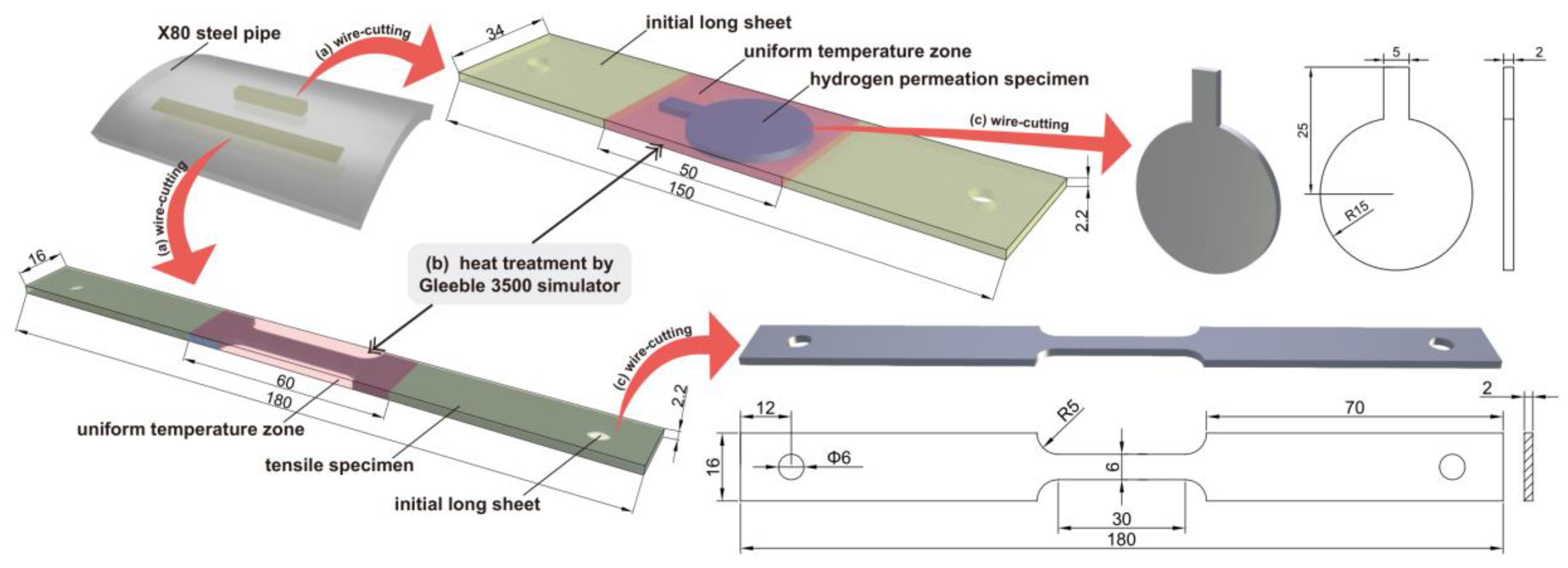
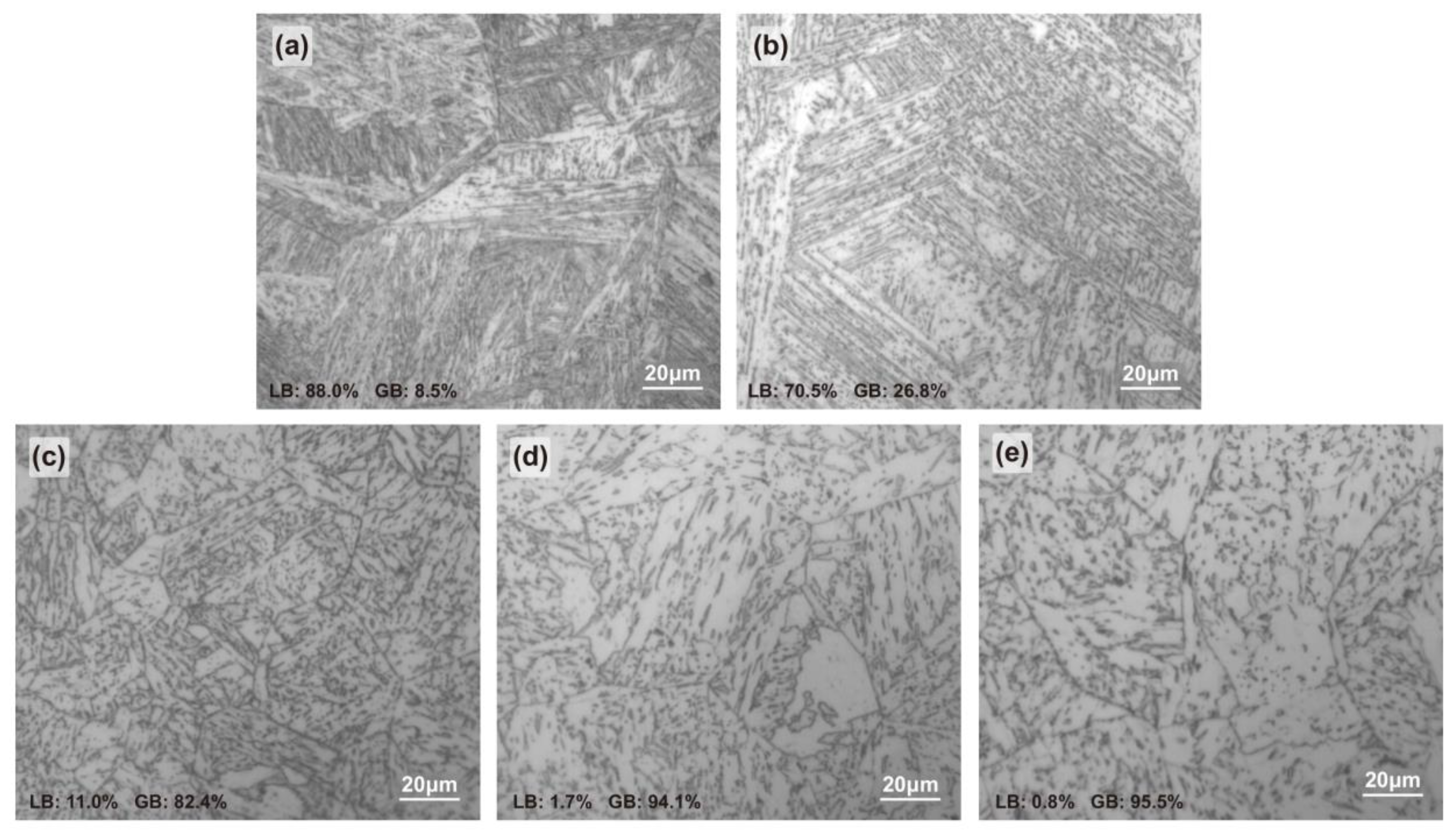

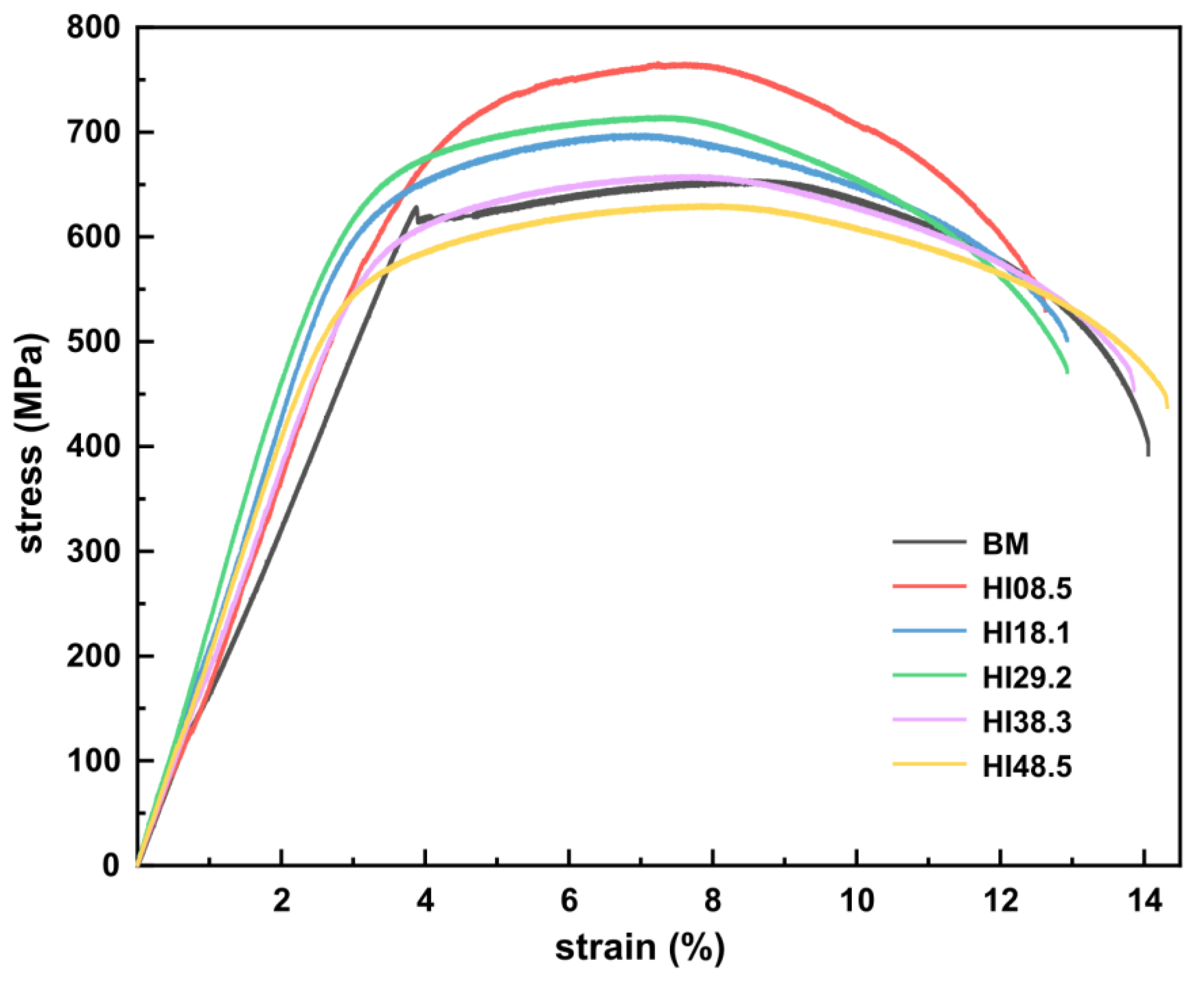
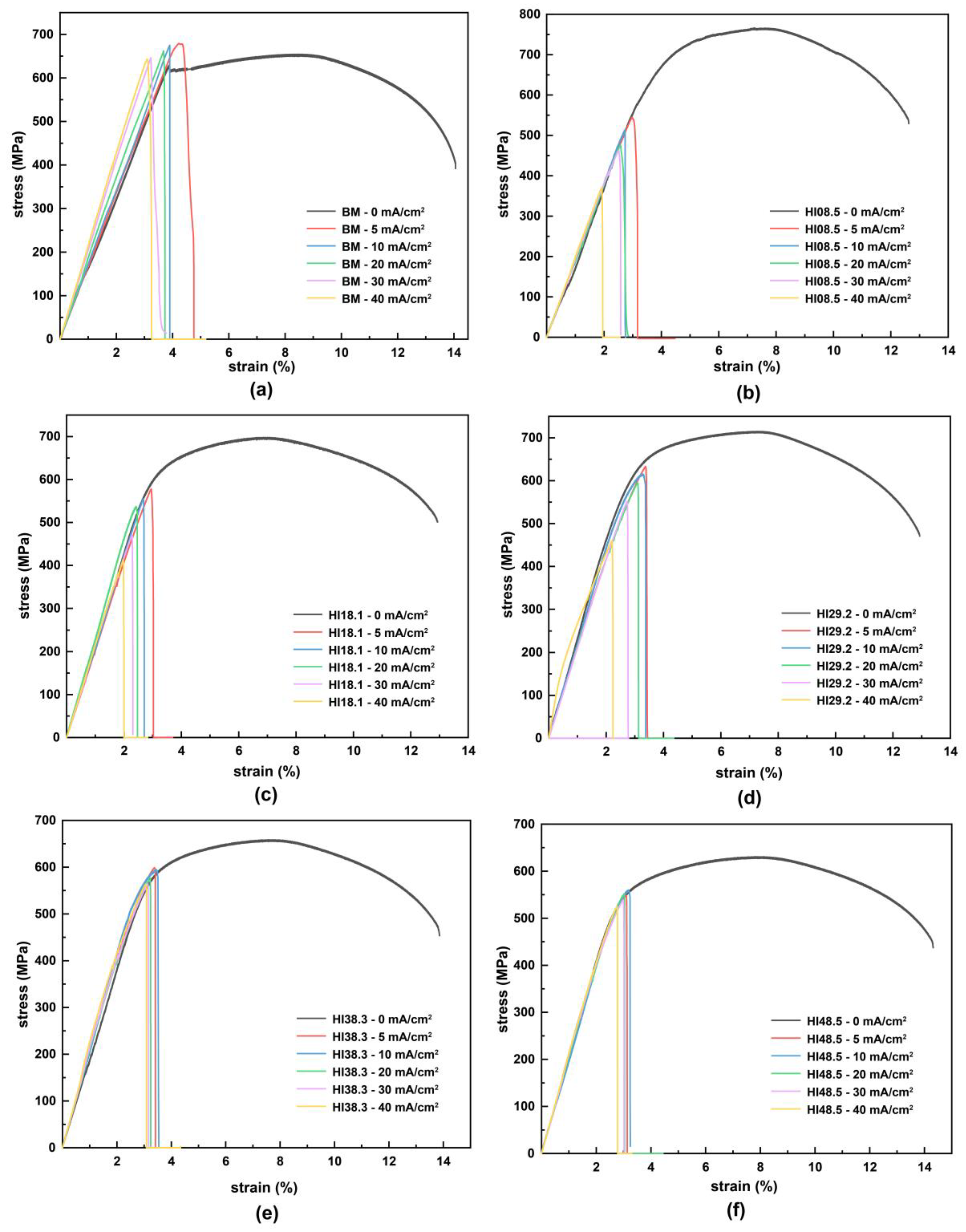



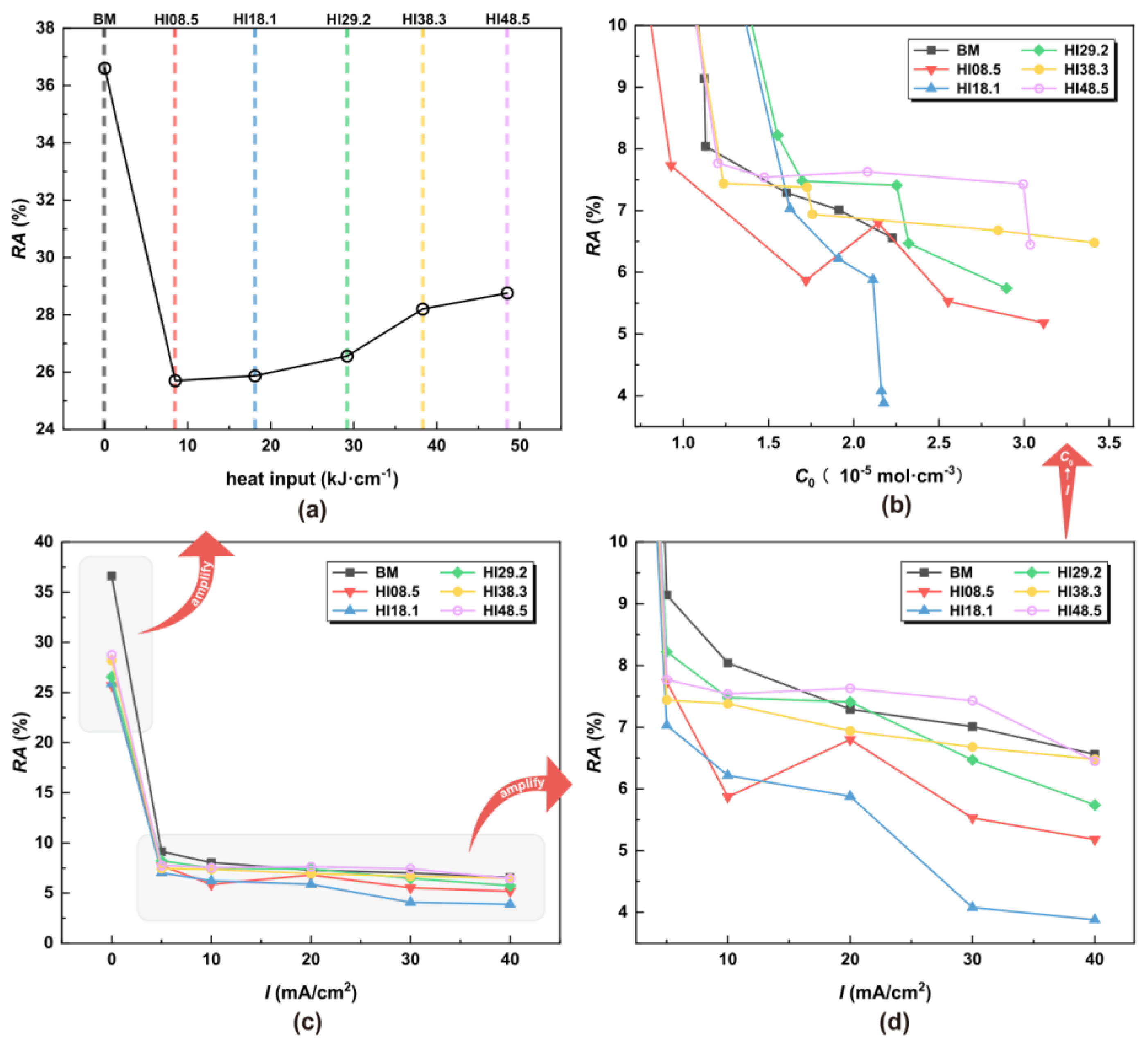
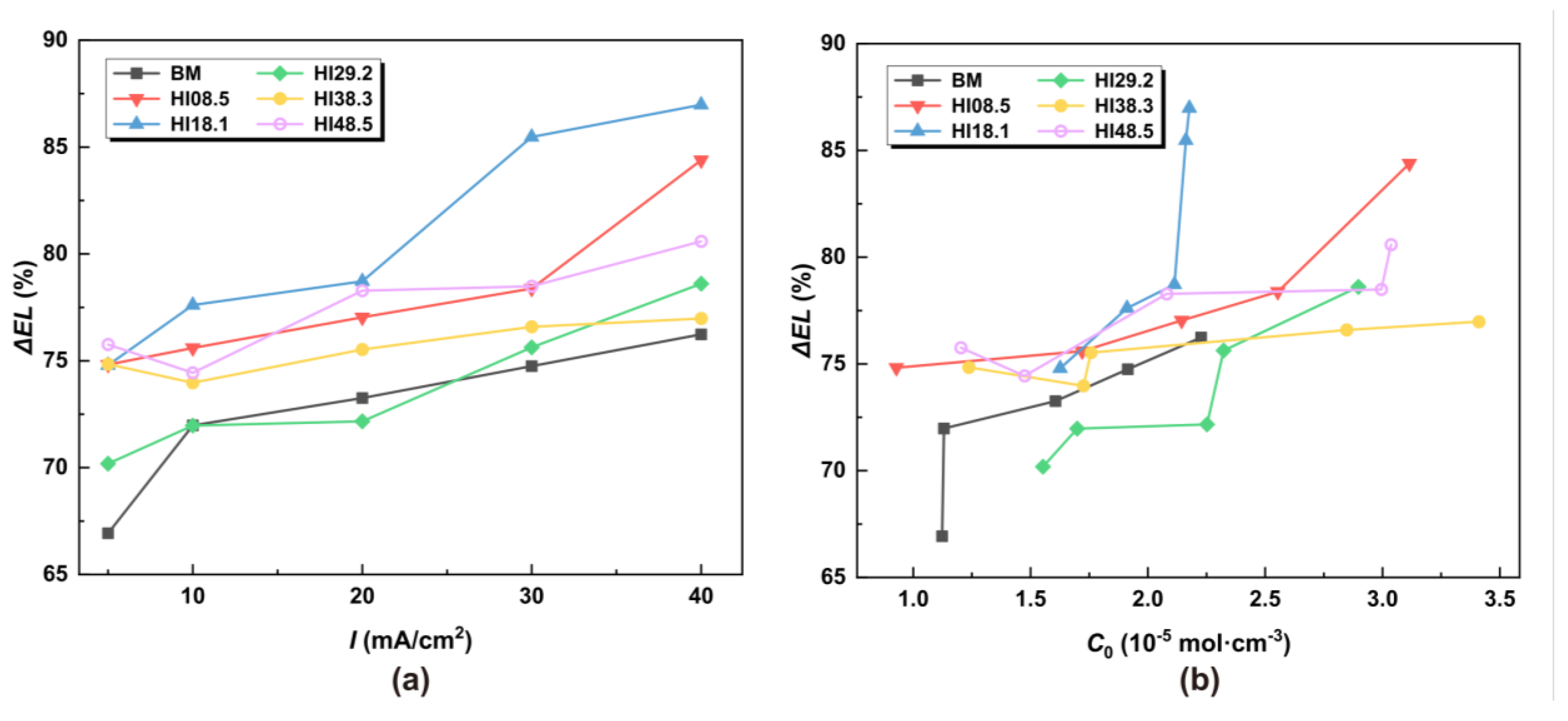
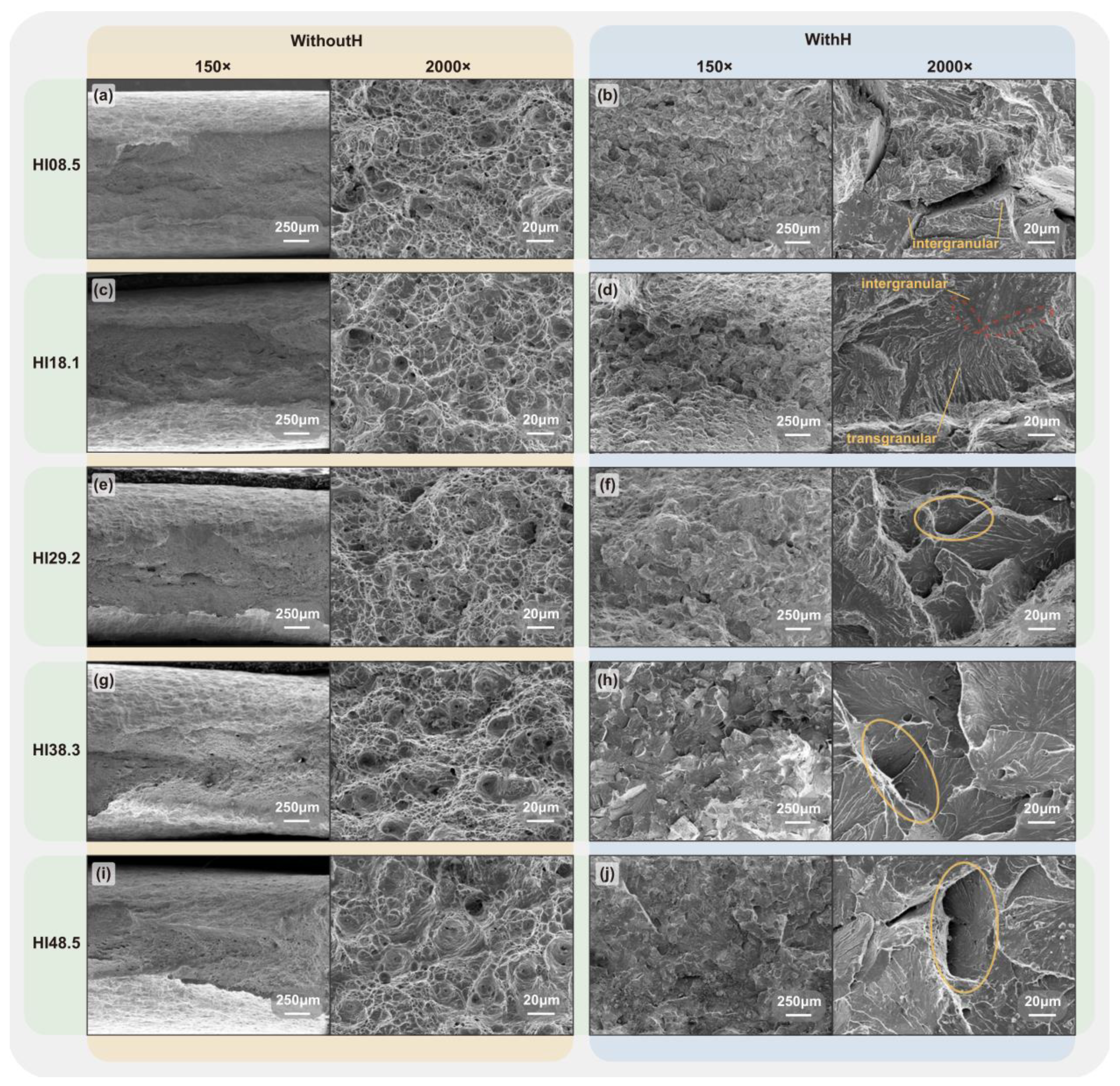

| Label | Heating Rate (°C/s) | Peak Temperature (°C) | Holding Time (s) | Cooling Time t8/5 (s) | Heat Input (kJ/cm) |
|---|---|---|---|---|---|
| HI08.5 | 150 | 1350 | 1 | 4.5 | 8.5 |
| HI18.1 | 15.5 | 18.1 | |||
| HI29.2 | 39.0 | 29.2 | |||
| HI38.3 | 68.5 | 38.3 | |||
| HI48.5 | 109.0 | 48.5 |
| Label | UTS (MPa) | RA (%) | EL (%) |
|---|---|---|---|
| BM | 654.28 | 36.61 | 14.06 |
| HI08.5 | 766.21 | 25.70 | 12.65 |
| HI18.1 | 697.95 | 25.87 | 13.14 |
| HI29.2 | 714.97 | 26.56 | 13.25 |
| HI38.3 | 658.58 | 28.20 | 14.05 |
| HI48.5 | 630.68 | 28.76 | 14.48 |
| D (10−6 cm2·s−1) C0 (10−5 mol·cm−3) | ||||||||||
|---|---|---|---|---|---|---|---|---|---|---|
| Label | I = 5 mA/cm2 | I = 10 mA/cm2 | I = 20 mA/cm2 | I = 30 mA/cm2 | I = 40 mA/cm2 | |||||
| D | C0 | D | C0 | D | C0 | D | C0 | D | C0 | |
| BM | 3.978 | 1.123 | 4.932 | 1.131 | 4.863 | 1.606 | 4.991 | 1.914 | 5.304 | 2.227 |
| HI08.5 | 3.123 | 0.928 | 3.025 | 1.72 | 3.454 | 2.144 | 3.687 | 2.554 | 3.834 | 3.115 |
| HI18.1 | 2.725 | 1.626 | 3.248 | 1.911 | 3.586 | 2.113 | 4.043 | 2.162 | 4.881 | 2.177 |
| HI29.2 | 3.287 | 1.553 | 3.348 | 1.699 | 3.440 | 2.252 | 3.641 | 2.323 | 3.953 | 2.897 |
| HI38.3 | 2.477 | 1.236 | 2.755 | 1.725 | 3.010 | 1.757 | 3.100 | 2.847 | 3.247 | 3.411 |
| HI48.5 | 3.079 | 1.203 | 3.152 | 1.474 | 3.157 | 2.080 | 3.447 | 2.995 | 3.521 | 3.036 |
| Label | LB and GB Content | Microstructure Distribution | Fracture Characteristics with Hydrogen | HE Resistance |
|---|---|---|---|---|
| HI08.5 | LB: 88.0% GB: 8.5% | mainly LB, finely intertwined | intergranular fracture | high susceptibility to HE |
| HI18.1 | LB: 70.5% GB: 26.8% | intergranular and transgranular mixed fracture | ||
| HI29.2 | LB: 11.0% GB: 82.4% | LB mixed with GB, LB dispersed in GB | transgranular fracture with stepped truncation | minimal susceptibility to HE |
| HI38.3 | LB: 1.7% GB: 94.1% | mainly GB | flat transcrystalline fracture | less affected by hydrogen concentration |
| HI48.5 | LB: 0.8% GB: 95.5% |
Disclaimer/Publisher’s Note: The statements, opinions and data contained in all publications are solely those of the individual author(s) and contributor(s) and not of MDPI and/or the editor(s). MDPI and/or the editor(s) disclaim responsibility for any injury to people or property resulting from any ideas, methods, instructions or products referred to in the content. |
© 2023 by the authors. Licensee MDPI, Basel, Switzerland. This article is an open access article distributed under the terms and conditions of the Creative Commons Attribution (CC BY) license (https://creativecommons.org/licenses/by/4.0/).
Share and Cite
Gou, J.; Xing, X.; Cui, G.; Li, Z.; Liu, J.; Deng, X. Hydrogen-Induced Cracking in CGHAZ of Welded X80 Steel under Tension Load. Metals 2023, 13, 1325. https://doi.org/10.3390/met13071325
Gou J, Xing X, Cui G, Li Z, Liu J, Deng X. Hydrogen-Induced Cracking in CGHAZ of Welded X80 Steel under Tension Load. Metals. 2023; 13(7):1325. https://doi.org/10.3390/met13071325
Chicago/Turabian StyleGou, Jinxin, Xiao Xing, Gan Cui, Zili Li, Jianguo Liu, and Xiangyuan Deng. 2023. "Hydrogen-Induced Cracking in CGHAZ of Welded X80 Steel under Tension Load" Metals 13, no. 7: 1325. https://doi.org/10.3390/met13071325
APA StyleGou, J., Xing, X., Cui, G., Li, Z., Liu, J., & Deng, X. (2023). Hydrogen-Induced Cracking in CGHAZ of Welded X80 Steel under Tension Load. Metals, 13(7), 1325. https://doi.org/10.3390/met13071325





